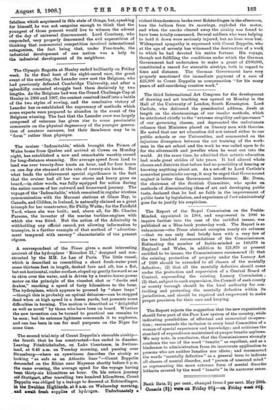The second trial-trip of Count Zeppelin's steerable airship— the fourth
that he has constructed—has ended in disaster. Leaving Friedrichshafen, on Lake Constance, in Switzer- land, at 6.4.5 a.m. on Tuesday morning, and passing over Strassburg—where an eyewitness describes the airship as looking "as safe as an Atlantic liner "—Count Zeppelin descended on the Rhine near Mayence shortly before 6 p.m. the same evening, the average speed for the voyage having been thirty-six kilometres an hour. On his return journey vid Stuttgart, after travelling two hundred kilometres, Count Zeppelin was obliged by a leakage to descend at Echterdingen, in the Swabian Highland, cit 8 a.m. on Wednesday morning, and await fresh supplies of hydrogen. Unfortunately a
violent thunderstorm broke over Eohterdingen in the afternoon, tore the balloon from its moorings, exploded the motor, and when the smoke cleared away the airship was found to have been totally consumed. Several soldiers who were helping to hold it down were seriously injured, but no lives were lost. Widespread sympathy is expressed with Count Zeppelin, who at the age of seventy has witnessed the destruction of a work to which he had devoted his entire fortune. His voyage, though not fulfilling the conditions under which the German Government had undertaken to make a grant of £100,000, constituted a record for steerable airships, both in regard to time and distance. The German Government have very properly sanctioned the immediate payment of a sum of £25,000 to Count Zeppelin as compensation "for his many years of self-sacrificing creative work."


































 Previous page
Previous page